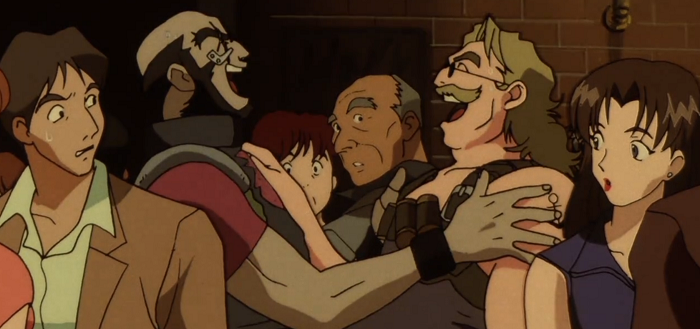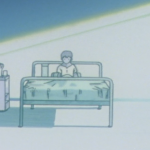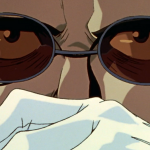Adios, Cowboy: An Interlude
Editorial note: My approach to reviewing Cowboy Bebop has always been to watch an episode and then write about it. I want to capture my feelings at the time, and then use those feelings to construct a meta-review that weaves its way into each episode’s review. When I wrote this review, I believed everything I wrote. I thought Cowboy Bebop was doing a good job of representing a human diaspora. If I knew then what I knew now, 22 episodes into the series, my praise would not have been quite so forthcoming. Cowboy Bebop has a real problem with the way it shows black people on screen. This is not a problem that is immediately obvious within the first half of the series. Before this project is done, I will revisit this controlling ideas of the words below in more detail. For the time being, I want to leave this review as it stands. Since my purpose in writing this series is to learn, and to show others what I have learnt so that they might learn, then mapping my where I was versus where I land is an essential part of the process.
A thought has been rattling around my head since Cowboy Bebop first took its audience through a dragon emblazoned, red and gold hyperspace gate to Mars. This show is making an effort to show a vision of the future that isn’t living under the heel of a single cultural hegemon. This might not sound like much, but stop to consider how contemporary science fiction, within respective universes, can be a rather dull monoculture.
Let’s dig into everybody’s favourite space western, Firefly, and really consider how many cultures we saw in play within the ‘verse. Sure, people spoke in English and swore in Mandarin, but what else have you got? Identity in Firefly was framed as a spectrum of economic strata (typically rich city folk and poor country folk) rather than representations of unique cultures. Bebop, though an older show, makes more of an obvious effort to project cultural uniqueness into a broader human diaspora.
Tijuana Asteroid, for example, has the appearance of a Latin American city, with signs and billboards in Spanish, and cuisine to match the venue. Half the reason Spike agrees to hunt Asimov Solensen and his meagre bounty is for a taste of the carnitas.
Mars’ crater cities are brimming with a Chinese aesthetic. I say this recognizing that modern China is a huge place, and multiple social and cultural identities comprise China as we know it today. There’s a perfect example of this nuanced take during Mao Yenrai’s treaty negotiation. He invites his formal rival to dinner and boasts of his cook’s talent for Cantonese food. Not Chinese food, but Cantonese food. Even Mars’ orbital casinos show a setting where an elevator’s “no smoking” sign is duplicated in ten different languages.
The future in Cowboy Bebop isn’t the spandex unisuits of Star Trek or the endless urban sprawl of Star Wars’ Coruscant. Mars is Byzantium. The gateway stations are port towns where a dozen different nationalities come together for common purpose. This future is no single vision, but a series of connected ideas set to smooth jazz connecting people as they go about their daily lives. They are citizens of something bigger while retaining an identity that is still unique.
This notion is germane to some contemporary discourses in fiction. If one were to ask ten science fiction writers for their thoughts on writing characters and places that exist outside the author’s culture and identity, they could expect at least fifteen opinions in response. I don’t propose to offer editorial on any of those opinions. As is so often the case with this project, I want to share where I think Cowboy Bebop is offering a lesson that my fellow cis-het-white dudes could emulate in their SF/spec fic, and perhaps raise their games without taking up space.
What Cowboy Bebop does well on this front is to show a range of people, not just the typical anime “white people,” and a range of places, not just future space Japan. It makes those places feel lived in without presuming to get into the weeds on the street-level politics of those places or the individual narratives of the people living those places.
There are Latinx people in Tijuana. There is a mix of Asian, European, and African people on Mars. Representation and visibility are part of the setting. The constant subtext from one episode to the next is that all of Earth’s people are a part of the Sol system’s interplanetary civilization.
Where the writing is particularly smart, and where I see the most pressing lesson for contemporary writers who might look like yours truly, is in its wisdom to stop well short of usurping the stories of the people it is representing. Abdul Hakim, for example, as a black character created by Japanese people. In and of itself, this representation is probably not a party foul unless one wants to start parsing his dress as a callback to blacksploitation films, and that would be a full essay unto itself. Editorial note: I wrote this before I watched Episode 17: Mushroom Samba. Looking back, Hakim, on his own, isn’t a problem, but Bebop does have some problems with how it represents black people, specifically.
Where I am certain the writing would get into trouble is if it tried to define what that blackness meant to Hakim.
Call it the Stacker Pentecost hypothesis. Therein, a Mexican writer-director created an oft quoted black character – possibly one of sci-fi cinema’s best characters in some time. Del Toro stayed on the side of the angels, so to speak, by telling the story of a Jaeger pilot turned resistance leader. If he tried to tell the story of what it meant for Stacker Pentecost to be a military leader and a black man, things might have ended differently. Then again, this is just my read on the situation. I don’t think I’m out of order, but I’ll gladly listen if anybody wants to tell me where I’m wrong.
Yet for everything Bebop does right on this front, there are still some moments where it sits on its own balls. Episode 7 reduces Mexican/Latinx identity to a prop. The three bounty hunter banditos that Spike and VT fight in a diner look like something out of a John Wayne movie. It’s a lazy move, and certainly one that would raise eyebrows among a modern audience. However, this misstep can be turned into a learning experience for neophyte creators watching Bebop. Specifically, if you want to show people who don’t look like you, do not reduce those differences to costumes and gimmicks akin to not needing no stinkin’ badges.
By and large, though, Bebop’s efforts seem to be coming from a place of respect and to my eyes look to be executed with a reasonable level of finesse. Editorial note: Past-Adam, you sweet summer child. If only you knew what was coming. I stand behind my thoughts seven episodes into the series, but yeah…things take a turn. This becomes a much more messy area. What I once saw as finesse on first blush, does not stand up to scruity amid repeated party fouls.
Cowboy Bebop makes the construction of a world that exists beyond the municipal boundaries in which a contemporary viewer lives seem like an effortless thing. From where I sit, I think that’s lesson worth thinking about over the long-term.













